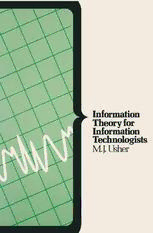Table Of ContentISBN 978-0-333-36703-2
9 780333 367032
InformationTheory for InformationTechnologists
Macmillan ComputerScienceSeries
Consulting Editor
ProfessorF. H.Sumner,University ofManchester
S.T. Allworth,Introduction to Real-timeSoftwareDesign
Ian O. Angell, A PracticalIntroduction to ComputerGraphics
G.M.BirtwistIe,DiscreteEventModellingon Simula
T.B.Boffey,GraphTheory in OperationsResearch
Richard Bornat,Understandingand WritingCompilers
J.K.Buckle, TheICL 2900Series
J.K.Buckle,Software Configuration Management
J. C.Cluley,InterfacingtoMicroprocessors
Robert Cole, ComputerCommunications
DerekColeman,A StructuredProgrammingApproach toData*
Andrew J. T.Colin, FundamentalsofComputerScience
Andrew J.T. Colin, ProgrammingandProblem-solvinginAlgol68*
S.M.Deen, FundamentalsofDataBaseSystems"
P.M.Dew and K. R.James,Introduction toNumerical Computation inPascal
K.C. E.Gee, Introduction to LocalArea ComputerNetworks
J. B.Gosling,DesignofArithmetic Unitsfor DigitalComputers
David Hopkinand BarbaraMoss,Automata"
Roger Hutty,Fortranfor Students
Roger Hutty,Z80AssemblyLanguageProgrammingfor Students
Roland N. Ibbett, TheArchitectureofHighPerformance Computers
H.Kopetz,SoftwareReliability
E.V.Krishnamurthy, Introductory Theory ofComputerScience
Graham Lee, From Hardwareto Software:anintroduction to computers
A.M.Lister,FundamentalsofOperatingSystems, secondedition*
G.P.McKeown and V. J.Rayward-Smith,Mathematicsfor Computing
Brian Meek,Fortran,PLj1and theAlgols
Derrick Morris, AnIntroduction toSystemProgramming - Basedon thePDPll
DerrickMorrisand Roland N.Ibbett, TheMU5 ComputerSystem
John Race, CaseStudiesinSystemsAnalysis
L.E.Scales, Introduction toNon-LinearOptimization
Colin J. Theakerand Graham R.Brookes,A PracticalCourseon Operating
Systems
M.J.Usher, Information Theory for Information Technologists
B.S.Walker, UnderstandingMicroprocessors
PeterJ.L.Wallis,PortableProgramming
I. R. Wilsonand A.M.Addyman,A PracticalIntroduction toPascal- with
BS 6192, secondedition
*Thetitles marked with anasterisk wereprepared duringthe Consulting Editorshipof
Professor J.S.Rohl, UniversityofWesternAustralia.
Information Theory
for Information
Technologists
M. J. Usher
Department ofCybernetics
University ofReading
M
MACMILLAN
©M.J.Usher 1984
Allrights reserved.No part ofthis
publication may bereproduced or
transmitted, inany form or by any
means,without permission.
Firstpublished1984 by
Higher and Further Education Division
MACMILLANPUBLiSHERS LTD
LondonandBasingstoke
Companies andrepresentatives
throughout the world
Typesetin 10/12PressRoman by
RDL Artset Ltd,Sutton,Surrey
British Library Cataloguingin Publication Data
Usher, J.
Information theory for information
technologists.-(Macmillan computer
science series)
1.Information theory
1.Title
001.53'9 Q360
ISBN978-0-333-36703-2 ISBN978-1-349-17648-9(eBook)
DOI 10.1007/978-1-349-17648-9
Contents
Preface ix
Acknowledgements xi
1 Informationand its Quantification
1.1 Introduction 1
1.2 Quantity ofinformation 2
1.3 Averageinformation;entropy 4
1.4 Redundancy 6
1.5 Exercises on chapter 1 6
2 Informationin Language 8
2.1 Basicprobability theory 8
2.2 Conditional entropy 11
2.3 Redundancy in printed English 12
2.4 Exercises on chapter2 14
3 Binary Coding in NoiselessChannels 16
3.1 Information channels 16
3.2 Binary codes 16
3.3 Compactinstantaneous codes 18
3.4 Coding methods 19
3.5 Shannon's first theorem 20
3.6 Applicationsofcompactcodes 22
3.7 Exercises on chapter 3 23
4 InformationTransferinNoisy Channels 25
4.1 Information innoisy channels 25
4.2 General expression for information transfer 28
4.3 Equivocation 30
4.4 Summary ofbasicformulae by Venn diagram 33
4.5 Channel capacity 34
4.6 Exercises on chapter4 36
5 BinaryCoding in Noisy Channels 38
5.1 Introduction 38
5.2 The binomialprobability distribution 38
v
vi CONTENTS
5.3 Binary coding for error protection 39
5.4 Practical codes for error detection and correction 42
5.5 Recent developmentsinerror-protection coding 48
5.6 Exerciseson chapter 5 49
6 Introductionto SignalTheory 51
6.1 Classification ofsignals 51
6.2 Time domain averages 53
6.3 Frequency domain averages 57
6.4 Summary oftime and frequency averages 59
6.5 Exerciseson chapter6 60
7 Electrical Noise 61
7.1 Types ofelectrical noise 61
7.2 Probability distributions 63
7.3 Time and ensemble averages 73
7.4 Summary of the properties of electrical noise 76
7.5 Exercises on chapter7 80
8 Time Domain PropertiesofSignals 81
8.1 Correlation 81
8.2 Autocorrelation 82
8.3 Cross-correlation 84
8.4 Convolution 84
8.5 Applicationsofcorrelation and convolution 88
8.6 Exerciseson chapter8 89
9 Frequency Domain RepresentationofSignals 91
9.1 FourierTheory 91
9.2 Finite power signals: Fourier Series 91
9.3 Finite energy signals: FourierTransforms 101
9.4 Summary 121
9.5 Exerciseson chapter9 121
10 Sampling Theory 127
10.1 Sampled signals 127
10.2 The spectrumofsampled signals 128
10.3 Impulse sampling 131
lOA Recovery ofsignalfrom samples 133
10.5 Exerciseson chapter 10 136
CONTENTS vii
11 InformationinContinuousSignals 138
11.1 Continuoussignals 138
11.2 Relative entropy ofcontinuoussignals 139
11.3 Informationcapacity ofcontinuoussignals 142
11.4 Deductionsfrom the idealtheorem 144
11.5 Exerciseson chapter 11 147
12 CommunicationSystems 149
12.1 Modulation 149
12.2 Analogue modulation 149
12.3 Pulsemodulation 156
12.4 Binary communication systems 160
12.5 Exerciseson chapter 12 165
13 Applicationsof InformationTheory 167
13.1 Typical information channels 167
13.2 Speech processing, synthesis and recognition 173
13.3 Optical character recognition 181
13.4 Musicsynthesis 183
13.5 ~xercises on chapter 13 185
14 Solutionsto Exercises 188
14.1 Solutionsto exerciseson chapter 1 188
14.2 Solutionsto exerciseson chapter2 188
14.3 Solutionsto exerciseson chapter3 190
14.4 Solutionsto exerciseson chapter4 193
14.5 Solutionsto exercises on chapter 5 195
14.6 Solutionsto exercises on chapter6 198
14.7 Solutionsto exercises on chapter 7 199
14.8 Solutionsto exercises on chapter8 203
14.9 Solutionsto exerciseson chapter9 205
14.10 Solutionsto exercises on chapter 10 215
14.11 Solutionsto exercises on chapter 11 215
14.12 Solutionsto exercises on chapter 12 218
14.13 Solutionsto exercises on chapter 13 219
ReferencesandBibliography 222
Index 224
Preface
InformationTechnology may be defined asthe acquisition,storage, processing,
communication and display ofinformation.Asatechnology itisunique inthat
it refers to an abstractconcept -- information;allprevious technologies have
been linked to specificphysicalconcepts.InformationTechnologyisthus
independentofthe physical technologies used to implementit,and its principles
willtherefore continue unchanged despite the considerable technological develop
ments expected in the next fewyears.
Information Theory,the scienceofquantification,coding andcommunication
ofinformation,isthe basisofInformationTechnology.Itisaprecise, quantita
tivetheory developed largelyduring and after the Second WorldWar.Some of
itstheoremswereat first considered impractical but recent technological develop
ments havechanged this and strongly underlined the importance of fundamental
theory asabasisfor technology.
The aimofthis bookisto present the fundamentals ofInformationTheoryin
amannersuitable for persons working in or interested inthe field of Information
Technology. Quantity ofinformationisfirst defined,and the conceptsof
entropy and redundancy introduced,with application to the Englishlanguage.
Informationinnoisy channels isthen considered,and variousinterpretationsof
information transfer presented:this leadson to the requirementofcoding
information before transmission,eitherin noiselessor noisy channels, and to
Shannon's fundamental theorem.
In order to consider more generalsignalsthan purely digitalor discrete signals,
areviewofsignaland noise theory isrequired,including probability distributions,
electrical noise, the Fourier Theory ofsignalsand samplingtheory.This paves
the way for astudy of the information capacityofageneralchannel and the
idealcommunicationtheorem.Finally areviewofcommunication systems is
presentedin the light ofInformationTheory,togetherwith examples of the
applicationsof InformationTheory to recent developmentssuch asspeech pro
cessingand recognition,sound generation,musicsynthesis and character
recognition.
The bookisbasedlargely on asecond-year course ofabout30lectures given
to Cyberneticshonours degreestudents.The approach adopted isone of
intuitive understanding ratherthan rigorous formal theory.It issuitable for both
specialistcoursesin InformationTechnology and for the newone-year conver
sioncourses;arts-based graduates on these courses areadvisedto omit chapters
8and9 on first reading. Manyofthe workedexamples and exercisesarebased
on ReadingUniversity examination questions setby the author,who ispleased
ix
x PREFACE
to acknowledge the University's permission to publish them.Hisonly regretis
thathehasseriously depletedhisstock ofsuch questionsfor future years. Early
retirementlooms largeindeed.
Reading,1984 M.J. USHER

